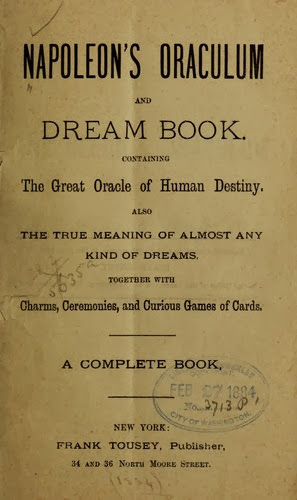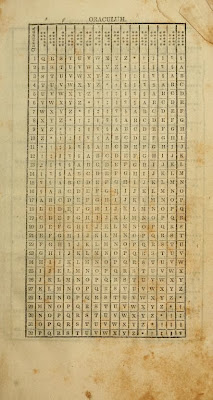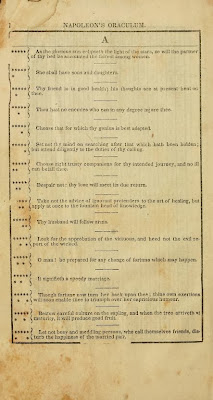Napoleon’s Oraculum (1839)
Link to Open Library page view
In 1813 Napoleon was defeated at Leipzig. However he left behind him a "Cabinet of Curiosities" among which a Prussian officer discovered the following Oraculum. Originally this Oraculum had been discovered in one of the Royal tombs of Egypt during a French military expedition of 1801.
The emperor ordered the manuscript to be translated by a famous German scholar and antiquarian, and was translated into English in 1822. From that time onwards the Oraculum remained one of the emperor’s most treasured possessions.
He consulted it on many occasions and it is said to have "formed a stimulus to his most speculative and most successful enterprises." As it states in the 1839 edition of the Oraculum, “Happy had it been for him, had he abided or been ruled by the answers of this Oracle.”
But more to the point, it is hard to imagine how a conquering emperor would use this book. The questioner is limited to a fixed list of thirty-two questions, most of which have nothing to do with military success. The answers tend to be little bits of conventional wisdom, more reminiscent of Poor Richard than of King Tut.
The Oraculum is said to have been used by the priests of the Delphic Oracle in Greece, which was world-renowned in ancient times and visited by distinguished individuals from far countries. Everyone consulted the Oracle before undertaking any new enterprise, such as a new business venture, a long journey, and particularly about love affairs.
The true origin of the Oraculum is unclear. Reportedly there were English translations in the 1820s but the most widely sold version was Boney’s Oraculum, or Napoleon’s Book of Fate, published in Ireland by James Duffy and Sons in 1830.
The Oraculum was published in America in the 1830s and the book remained popular, with numerous editions, throughout the century. There were several twentieth century editions but the book is out of print today. Public Domain Review has two editions, one from 1839 and one from 1923.
Napaleon's oraculum and dreambook Published 1839 by s.n. in New York. Written in English.
L-Another
1884 Edition
BOOK OF FATE Napoleon 1923 EGYPT Oraculum - There is also this more elaborate edition from 1923, which gives lots more information in its introductory pages, as well as a transcription of a note apparently found with Napoleon’s copy in his own handwriting detailing the answers he recieved from the Oraculum to a series of questions.
First H.S. Nichols Edition, hardcover, brown
boards with gilt lettering and designs on front, back and spine, dimensions 8
1/2" X 6", 99 pages, unusual pagination. Book features a 17" X
14 1/2" foldout on linen cloth entitled: "QUESTIONS which may be put
to the ORACLE and which may be truly answered according to the HIEROGLYPHICAL
INDICATIONS of the PLANETS."
From title Page: "The Book Of Fate,
Formerly In The Possession Of And Used By Napoleon Rendered Into The English
Language By H. Kirchenhopper From A German Translation Of An Ancient Egyptian
Manuscript Found In The Year 1801 By M. Sonnini In One Of The Royal Tombs Near
Mount Libycus In Upper Egypt New York H. S. Nichols MCMXXIII".
How to use Napoleon’s Oraculum for Divination
To foretell the future, the diviner first selects a question from the printed list. Then the diviner draws five rows of lines, “taking care that each row shall contain more than twelve lines or marks; but by no means to do so studiously, or count the marks till the five rows are completed.” The lines are counted, and for each row if the number is even the user draws two stars, if odd one star:
Using the arrangement of stars and the question number, the diviner looks up a symbol (a letter, punctuation mark, or faux hieroglyph) from the “Key.”
Here are the instructions from the 1839
edition of Napoleon’s Oraculum:
In the printed version of Napoleon’s Oraculum, the user
was required to use a pen or pencil to make five rows of lines, as randomly as
possible.
The number of lines in each row is used to create five rows of one or
two stars.
The question number and the stars are used to extract a symbol from
a table.
The symbol and the stars are used to look up the answer from a second
table.
Sources:
Public Domain Review:
- Napaleon’s Oraculum and Dreambook; 1839; S.N., New York.
- The Book of Fate, formerly in the possession of and used by Napoleon rendered into the English language by H. Kirchenhoffer, from a German translation of an ancient Egyptian manuscript found in the year 1801 by M. Sonnini in one of the royal tombs near Mount Libycus in Upper Egypt; 1923; H.S. Nichols, New York
- snakeoilgraphics.com/NightStick
- worthpoint.com/worthopedia













No comments:
Post a Comment